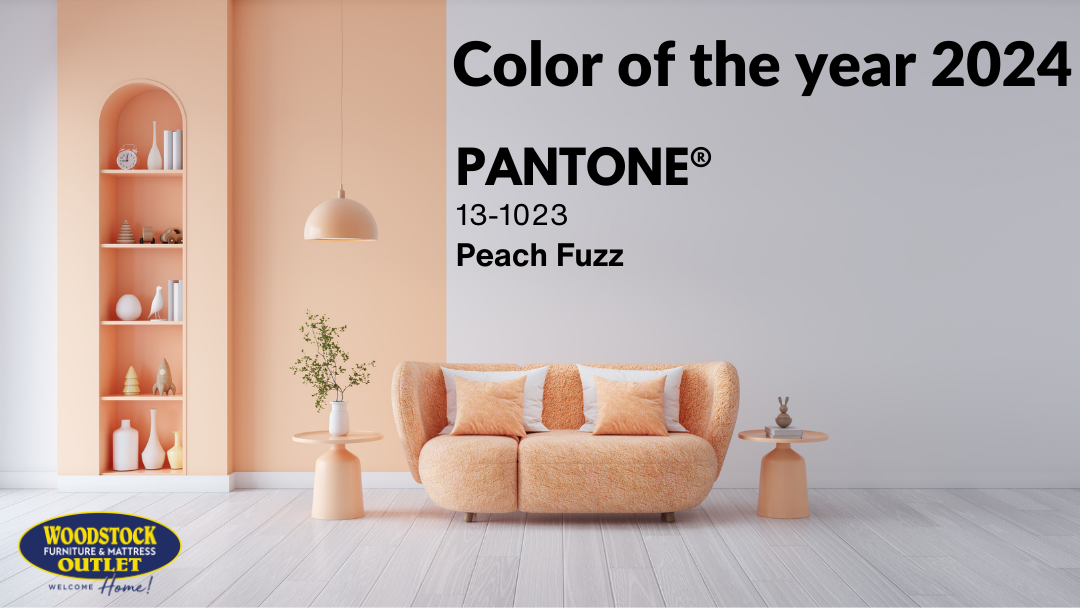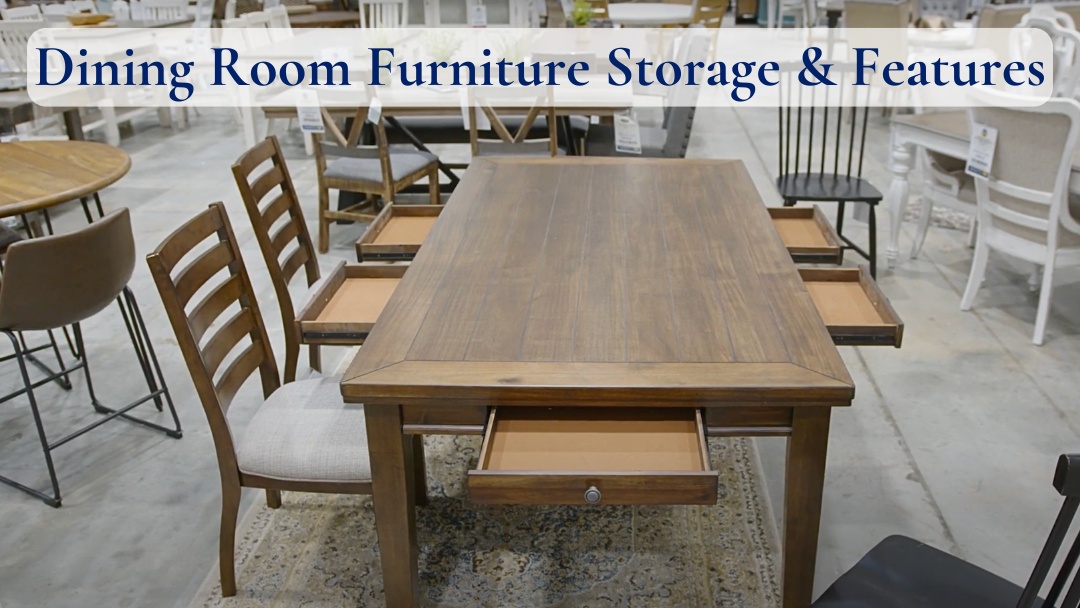Real talk — most of us aren’t decorators or interior designers. So, with seemingly hundreds of décor styles out there, it’s quite easy to be overwhelmed. From modern farmhouse to mid-century modern, French provincial to grandmillenial, industrial chic to coastal chic, and everything in-between, how are we supposed to keep them all straight?
Here at Woodstock Furniture & Mattress Outlet, in an effort to simplify things and preserve our customers’ sanity, we like to break it down into 3 broad décor styles — traditional, transitional and contemporary (i.e. modern). Just like there are 3 primary colors, it’s easy to remember that there are also 3 primary décor styles. These decorating and design styles span every category of furniture, every rug and every piece of décor in our showroom. However, today we’ll be speaking specifically to those of you wanting to learn more about different dining room styles.
What are the aesthetic features of a Traditional Dining Room? What does it mean to have a Transitional Dining Room and what characteristics make dining room furniture “transitional”? Exactly what is a Contemporary Dining Room and what characteristics does contemporary dining furniture have? By the end of this brief article, you’ll have a better understanding of what each style is and which style is best for your dining room, kitchen, or other dining space!

Traditional Dining Room vs Transitional Dining Room vs Contemporary Dining Room: What Are They & What Are Their Features?
Most of us have our own set of stylistic preferences. Our own personal brand, if you will. Is your look laid-back and casual, or clean-cut and formal? Whimsical or straight-to-business? These individual tastes – and the decisions informed by them – span the shoes we wear, to the cars we drive, to the furniture in our dining rooms. However, most of us haven’t really taken the time to ponder our own unique, individual tastes. Have you ever stopped to consider what your own personal style is?
[Editor’s Note: If not, you should absolutely check out our free online style quiz, but we’ll circle back to that later!]
Whether kitchen or dining room, these are the spaces in the home where we welcome guests and gather together with friends and family. Shouldn’t that space reflect you? To figure out which dining room style is right for your home, we need to define what Traditional Dining Rooms, Transitional Dining Rooms, and Contemporary Dining Rooms look like, and how they are furnished.
What Is Traditional Dining Room Style?
Traditional style is meant to be classic and timeless. Traditional Dining Rooms are inspired by a number of diverse style sub-categories that can trace their roots to a few decades ago, or a few centuries ago. For example, wide-ranging styles like farmhouse, cottage, Victorian, American colonial, and yes, even newer revival styles like bohemian and grandmillennial are all considered to be largely traditional.

Some of these dining room styles are ornate and decorative, while others are simple and practical. A Traditional Dining Room could feature a rustic farmhouse table with a bench, elegant Queen Anne dining chairs, or a simple Amish or Shaker style dining set. The key here is that traditional dining styles must come from an established design history. If you have a deep appreciation for time-honored traditions, history, antiques, or vintage aesthetics, a Traditional Dining Room is likely a great fit for your home.
What Features Make Dining Room Furniture Traditional?
Since traditional dining room furniture can be either casual or formal, the features can vary somewhat. However, there are several consistent characteristics.
For the lengthy history of furniture making, dining tables have traditionally been long, wooden, and rectangular. This holds true to this day, although many oval dining tables can be considered traditional as well. A much more telling sign of traditional dining furniture is when pieces have a darker wood or finish, like mahogany, walnut or cherry.
Additionally, traditional dining tables and chairs nearly always have decorative turned legs, spindle legs, cabriole legs, or ornately carved pedestals. This even goes for more casual traditional looks. As for dining chairs, timeless designs like x-back, ladder-back, slat-back, spindle-back or Windsor chairs all feel right at home in a traditional dining room.
What Is Transitional Dining Room Style?
As you might guess, Transitional Dining Rooms feature a blend between traditional styles and more modern/contemporary styles. Typically, transitional pieces take an established traditional style and update it, or deconstruct and reinterpret it to make something that feels new, yet somehow familiar.
The fun part of Transitional Dining Rooms is that unlike their traditional and contemporary counterparts, they aren’t really bound by any rules or assumptions. Modern farmhouse, industrial chic, coastal, casual, and rustic are all great examples of eclectic, transitional style. These styles are great for those who want to honor the past while gazing ahead towards the future.
What Features Make Dining Room Furniture Transitional?
So how does one take a traditional aesthetic and make it transitional? Most often, this is done by swapping a traditional color palette (often darker wood finishes) to something more neutral or monochromatic. Particularly shades of varying shades white, gray, or taupe.
For instance, a transitional dining set may be indistinguishable in design from a similar traditional dining set aside from a white-washed or gray finish. If a transitional dining set has upholstered dining chairs, the same goes for those too. Instead of the bold colors and patterns found in traditional upholstery, you’ll often find the same pattern in a much lighter color or hue. Speaking of upholstered dining chairs, since transitional style is truly a blend of traditional and contemporary, there’s a lot more flexibility when matching dining chairs to your dining table or buffet table.
Another sign of transitional dining room design is the simplification or streamlining of the more ornate details found in traditional pieces. Where you may have the same wood construction as a traditional piece, the shapes and angles may be more reminiscent of contemporary styles.
What Is Modern or Contemporary Dining Room Style?
Finally, we come to the Contemporary Dining Room and with it, contemporary style (often known as on-trend or modern). Unlike established traditional styles, contemporary styles are always changing. However, in the current day, contemporary styling is typically sleek, streamlined, and minimalist.
Since the mid 20th century, many décor and design styles grew and flourished that we now consider contemporary. Contemporary décor includes long established styles such as mid-century modern and Scandinavian, but also more recent additions like rustic modern. If you want a practical and functional dining space with a forward-looking design (and without unnecessary frills and decoration), a Contemporary Dining Room might be perfect for you.
What Features Make Dining Room Furniture Contemporary?
Finally, of the 3 key dining room styles, contemporary dining furniture is generally the easiest to spot. This is for several reasons.
First, contemporary dining tables and chairs are often constructed using mixed materials. This means that rather than a traditional all-wood construction, contemporary dining sets often incorporate materials like metal, glass, stone, concrete or even sturdy plastics. While many modern pieces are still crafted from wood, use of these other materials is a sign you’re likely looking at a contemporary dining set.
The other telltale sign of contemporary dining furniture is the presence of lots of clean, straight lines and sharply-angled corners — think squares and rectangles with lots of right angles. Much like contemporary upholstery, contemporary dining style has minimal decorative flourishes unless they add to the function of the piece. Dining chairs indicative of a contemporary dining room would be upholstered parsons chairs, wingback dining chairs, or keyhole dining chairs.
Which of These Different Dining Room Styles is a Good Fit for You? Be Sure to Take Our Free Style Quiz!
Now that you’re equipped with knowledge about the 3 key dining room styles, you should have a good idea which one is the best fit for you. Also, don’t forget to take the free décor style quiz on our website! Head back to our homepage, browse around, and watch for a link to the style quiz on the right margin.
Lastly, whether you’re looking for dining tables, dining chairs, dining benches, servers, buffet tables, sideboards, kitchen islands, or barstools, we have a wide variety of dining furniture available for Traditional Dining Rooms, Transitional Dining Rooms, Contemporary Dining Rooms, and kitchens too. Come see our huge selection online or at our 3 metro Atlanta and North Georgia furniture stores!
[Editor’s Note: For similar décor advice on upholstered seating and area rugs, don’t miss our comparison of Traditional, Transitional & Contemporary Rugs, and our discussion on Contemporary vs Transitional vs Traditional upholstery styles!]









